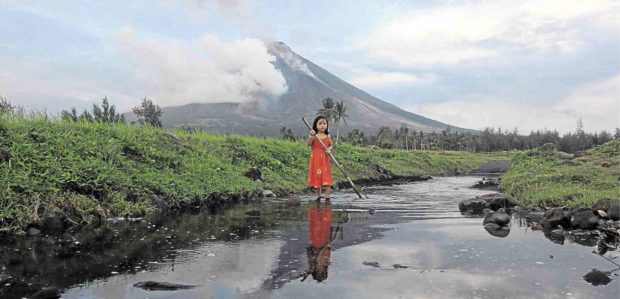Albay evacuees go home as Mayon alert lowered

PLAYTIME A girl finds time to play in a creek at Busay village in Daraga town, Albay, unmindful of ash and lava being spewed out by Mayon volcano. —GEORGE GIO BRONDIAL
Published: 11:56 a.m., Feb. 6, 2018 | Updated: 10:45 p.m., Feb. 6, 2018
LEGAZPI CITY — Almost two months after leaving their villages due to threats from the activity of Mayon volcano, 14,520 families staying in evacuation centers in Albay province are finally returning home.
This was after the Philippine Institute of Volcanology and Seismology (Phivolcs) on Tuesday lowered the alert status over Mayon from Level 4 (hazardous eruption imminent) to 3 (decreased tendency toward hazardous eruption) as it noted a general decline in the volcano’s activity.
Cedric Daep, chief of the Albay Public Safety and Emergency Management Office, said Gov. Al Francis Bichara on Tuesday signed the order directing local disaster councils in six towns and three cities to allow more than 54,000 evacuees to return to their communities within the 7- to 8-kilometer extended danger zone around the volcano. The order covered the towns of Guinobatan, Camalig, Daraga, Bacacay, Malilipot and Sto. Domingo, and the cities of Ligao, Legazpi and Tabaco.
Decampment order
Celerina Nuñez, 80, a resident of Legazpi City, thanked local officials for feeding them and providing their other needs during their stay in evacuation centers.
Article continues after this advertisement“I can now continue weaving abaca and making broomsticks, which is my major source of income,” she said.
Article continues after this advertisementLocal officials said the order to decamp would help decongest 61 designated evacuation centers in the province.
But Daep said 10,836 people, belonging to 2,665 families, needed to stay in 13 evacuation centers and wait for the Phivolcs to lower the alert level to 2 before they could return to communities inside the 6-km radius permanent danger zone covering 11 villages in the towns of Daraga, Camalig, Malilipot and Guinobatan and Tabaco City.
In a bulletin released on Tuesday, Phivolcs said Mayon’s condition in the past week had been “characterized by a general decline in unrest.”
The agency monitored moderate seismicity and degassing, deflation of the edifice and a decrease in eruptive activity at the summit crater.
But Phivolcs warned local officials and residents not to be complacent as sudden eruptions, lava collapse, pyroclastic density current and ashfall events were possible.
“[The lowering of the alert level] does not mean that the eruption is finished,” said Mariton Bornas, chief of Phivolcs’ volcano monitoring and eruption prediction division.
Minor eruptions
Eduardo Laguerta, Phivolcs resident volcanologist, said even when there was no alert status, the volcano could erupt anytime “because of shallow sources that cannot be detected by our instruments.”
He said small or minor eruptions should be expected.